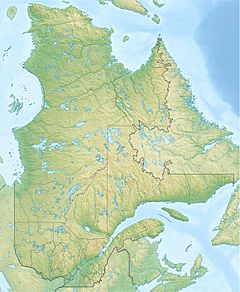Little Mecatina River facts for kids
Quick facts for kids Little Mécatina River |
|
|---|---|
| Native name | Nataukamiu Hipu |
| Other name(s) | Rivière du Petit Mécatina |
| Country | Canada |
| Province | Quebec |
| Region | Côte-Nord |
| RCM | Le Golfe-du-Saint-Laurent |
| Physical characteristics | |
| Main source | Newfoundland and Labrador 52°44′09″N 63°03′15″W / 52.735838°N 63.054263°W |
| River mouth | Gulf of Saint Lawrence 50°39′24″N 59°25′46″W / 50.65667°N 59.42944°W --> |
| Length | 545 kilometres (339 mi) |
| Basin features | |
| Basin size | 19,590 square kilometres (7,560 sq mi) |
The Little Mécatina River (also called Rivière du Petit Mécatina in French) is a big river in Canada. It flows through the Côte-Nord region in Quebec and also through Labrador. People have studied the river to see if it can be used to make electricity. This is called hydroelectric power. It could produce a lot of power, enough for many homes.
The river was first explored by kayak in 1973. Two German adventurers, Rolf Theiß and Fritz Gottensrtöter, paddled down it.
Contents
Where is the Little Mécatina River?
The Little Mécatina River is about 590 kilometres (370 mi) long. A large part of it, about 384 kilometres (239 mi), is in Labrador. The river starts near Lake Aticonac. This area is close to the border between Quebec and Newfoundland.
The river flows mostly to the southeast. Then it turns south. Finally, it empties into the Gulf of Saint Lawrence. This is a large arm of the Atlantic Ocean. The river's mouth is near Little Mecatina Island.
The Nétagamiou River is another river that joins the Little Mécatina. It splits off about 23 kilometres (14 mi) before the Little Mécatina reaches the sea. The river's mouth is in a place called Côte-Nord-du-Golfe-du-Saint-Laurent. This area is part of the Le Golfe-du-Saint-Laurent Regional County Municipality.
What Does the River's Name Mean?
The local Innu people have a special name for the river. They call it Nataukamiu Hipu. This means "river with broken waters." The Naskapi people call it Kuekuatsheunekap Shipu, which means "wolverine river."
The name Mécatina comes from the Innu language. The word makatinau means "large mountain." In the Cree language, it can mean "red mountain" or "large mountain."
In the past, people used "Petit" (Small) and "Gros" (Big) to tell apart two trading posts. These posts were set up in the 1700s. The rivers leading to these posts were then called the Little Mecatina River and the Big Mecatina River.
Fishing for Salmon
The Little Mécatina River is a place where people can fish. In 2017, there were special rules for salmon fishing. On this river and several others, all salmon had to be released back into the water. This rule helped protect the salmon population.
How Much Water Flows in the River?
The area that drains into the Little Mécatina River is huge. It covers about 19,590 square kilometres (7,560 sq mi). More than half of this area is in Labrador.
The amount of water in the river changes throughout the year.
- In spring, when the snow melts, the river floods.
- In summer, the water level goes down.
- In fall, it rises again.
- In winter, the water level is at its lowest.
For example, near the river's mouth, the water flow is highest in May. It is lowest in March.
Making Electricity: Hydroelectric Power
Hydro-Québec is a company that makes electricity in Quebec. They have thought about building a big hydroelectric power plant on the Little Mécatina River. This project could create 1,200 MW of power. This is enough to power many homes and businesses.
The plan involves building three dams on the river. These dams would create reservoirs (large lakes). This would flood about 228 square kilometres (88 sq mi) of land. The La Romaine Band Council, who are local Indigenous people, would need to agree to this project.
Studies for this project began in 2002. Leaders in Quebec have talked about starting a major hydroelectric project. The goal is to make sure there is enough electricity for the future. If approved, the dams could be ready around 2038 or 2040.


